Gallic Empire
Gallic empire: between 260 and 274 an independent part of the Roman empire.
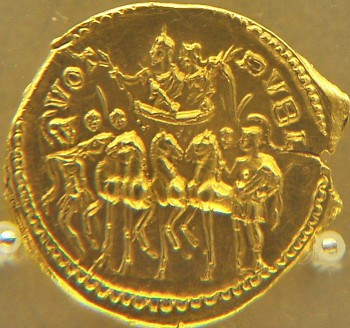
The history of the Gallic Empire needs to be deduced from several notoriously unreliable sources, like the Historia Augusta. Fortunately, the historian also benefits from the information offered by coins and archaeology, and a couple of other, late sources. Yet, much must remain uncertain.
Crisis
Our story begins in the mid-250s, when the Roman Empire experienced a grave crisis. In 253, the Sasanian king Shapur had invaded Roman Syria, and the emperor Valerian had gone to the east to conduct military operations against the enemy. Because he needed well-trained soldiers, he removed several units from the Rhine frontier, which was immediately overran by Germanic tribes (Franks and Alamans). Archaeology shows what happened in 256. Many forts along the Lower Rhine were destroyed. The inhabitants of Krefeld had no opportunity to mourn their dead and were forced to throw them in an underground sanctuary of Mithras. Trier was sacked. The only surviving city was Cologne, the capital of Germania Inferior, which was saved by its giant walls.
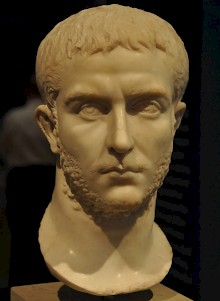
Valerian sent his son Gallienus to Gaul, where he liberated Trier, reorganized the defense of Germania Superior and Gallia Belgica, and managed to expel the Franks. However, his success was not the result of a military victory: he had paid lots of gold to another Germanic tribe, which attacked the Frankish homeland. In 259, large parts of the Rhine frontier had been restored, and Gallienus could call himself Germanicus Maximus, "greatest conqueror of the Germanic tribes". Meanwhile, he had regrouped the armed forces and had reformed parts of the fiscal system. The emperors of the Gallic Empire greatly benefited from this reorganization.
Gallienus left the recapture of the forts along the Lower Rhine to the governor of Germania Inferior, Postumus. However, he had to interrupt his campaign in 260, on hearing bad news from the east: during the Persian war, Gallienus' father Valerian had been taken captive by his enemy, the Sasanian king Shapur. This was the incentive the Germanic tribes needed, and Frankish and Alamannic warlords crossed the Rhine again. Within a few months, they had reached northern Italy, where they were finally repelled by Gallienus.
Postumus saves Gaul
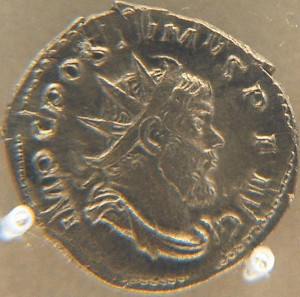
While Gallienus was, as Rome's official emperor, defending the Mediterranean world, Postumus restored order in the Dutch river area. The Historia Augusta describes how he became emperor:
This man, most valiant in war and most steadfast in peace, was so highly respected for his whole manner of life that he was even entrusted by Gallienus with the care of his son Saloninus (whom he had placed in command of Gaul) as the guardian of his life and conduct and his instructor in the duties of a ruler.
Nevertheless, as some writers assert -though it does not accord with his character- he afterwards broke faith and after slaying Saloninus seized the imperial power. As others, however, have related with greater truth, the Gauls themselves, hating Gallienus most bitterly and being unwilling to endure a boy as their emperor, hailed as their ruler the man who was holding the rule in trust for another, and dispatching soldiers they slew the boy.
When he was slain, Postumus was gladly accepted by the entire army and by all the Gauls, and for seven years he performed such exploits that he completely restored the provinces of Gaul, while Gallienus spent his time in debauchery and taverns and grew weak in loving a barbarian woman. Gallienus, however, was warring against him at that time when he himself was wounded by an arrow.
Great, indeed, was the love felt for Postumus in the hearts of all the people of Gaul because he had thrust back all the Germanic tribes and had restored the Roman Empire to its former security. But when he began to conduct himself with the greatest sternness, the Gauls, following their custom of always desiring a change of government, at the instigation of Lollianus put him to death.note
Not all this is untrue, but this texts contains many errors. Postumus was not the guardian of Saloninus; he obtained the throne in a different way; reigned longer than seven years; and was not killed at the instigation of Lollianus - whose real name, by the way, was Laelianus. Gallienus was less indolent than the author of the Historia Augusta suggests, and the remark that the Gauls are "always desiring a change of government" tells a lot about the classical attitudes towards the people living on the edges of the earth, i.e., beyond the Alps.
What really happened, was probably something like this. As governor of Germania Inferior, Postumus was responsible for the war against the Franks, who invaded the Roman emperor again in the summer of 260 after the news of the defeat of Valerian. Postumus was a capable commander, and somewhere near the shrine of Hercules Magusanus at Empel, he defeated the invaders.
His victory must have been decisive, because we don't hear about Germanic raids for more than a decade. This may be connected by one of Postumus' measures: he allowed several defeated warriors to remain in the empire as farmers, under the condition that they would fight against new invaders. This led to a reoccupation of abandoned farmland, but this policy, which had been initiated long time ago by Marcus Aurelius, had, as we shall see, only limited results.
A New Empire
The spoils of Postumus' victory were considerable, and Gallienus' son Saloninus, who was technically Postumus' superior, demanded his share. The soldiers who had fought against the Franks were angry, and proclaimed their commander emperor. Within a few months, Saloninus was dead, and Postumus was master of all provinces north of the Alps. This was the beginning of an independent and strong Gallic Empire, which lasted for fourteen years and occupied all of Gaul, Britain, and Spain.
| Postumus |
|
| Laelianus |
|
| Marius |
|
| Victorinus |
|
| Tetricus |
|
Gallienus, who had within a single year lost his father and son, crossed the Alps to fight against Postumus, but the latter refused to engage. It is said that the official emperor even challenged the Gallic emperor to a single combat, but Postumus refused this armed conflict too. In the end, both men agreed that they would not fight against each other, and would only defend the civilized world against its external enemies.
Postumus kept his word. When rebels in northern Italy invited him to be their ruler, he refused. Gallienus, on the other hand, felt free to break his promise and in 265 tried to reconquer Gaul. Again, Postumus evaded his opponent, and when Gallienus was wounded during a minor engagement, he returned to Italy.
The Gallic Empire is an expression of the self-confidence of the northern provinces. If the central government was unable to defend the Rhine frontier, the Gauls would do it themselves. And successully so. In 262-263, Postumus crossed the river to attack the Franks and Alamans at home, and after this, all remained quiet.
Defense in Depth
It is almost certain that one instrument to control the Germanic tribes was an alliance with the Thuringi, a tribe that lived beyond the Franks and Alamans. This alliance is not recorded in our sources, but can be deduced from hundreds of gold pieces with the portrait of Postumus, which are only found in the territory of the Thuringi, and nowhere else in Germania. The only explanation is that Postumus paid this tribe, which also seems to have served as soldiers in the new forts that were erected along the Rhine frontier.
Postumus' most important contribution to the stability of the Gallic empire was a new military strategy, which is called defense in depth. He understood that one line of forts along the Rhine was insufficient: if the tribal warriors broke through, it was impossible to stop them. Along the river, he stationed frontier troops; he constructed a line of guardposts along the line Aardenburg - Velzeke - Mechelen - Tongeren - Maastricht - Cologne; and behind this line, he positioned cavalry units, which could swiftly move to any sector under attack. In this way, the Franks could never threaten the important road between Boulogne, Bavay, Tongeren, and Cologne and the important fertile loessial soils. A similar system was developed along the Middle Rhine, where Central Gaul was defended against the Alamans.
This system of "defense in depth" was not Postumus' own invention. He had copied it from Gallienus, who had tried it along the Danube. In many other aspects the Gauls imitated the official empire. They had an emperor, Roman-style legions, coins, governors, consuls, other magistrates, and a Senate. Because the Gallic Empire was well-organized, it could survive its founder.
A New Crisis
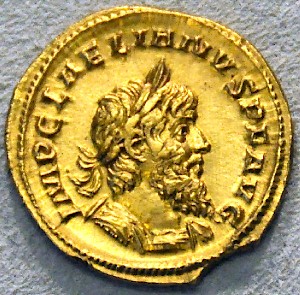
Postumus' end came in 269. His coins had always been of a better quality than those of the official empire, but in 268, he suddenly lowered the amount of silver in his coins. This created some unrest, and a man named Laelianus benefited. Proclaiming himself emperor, he seized the mint of Cologne and made Mainz his capital. Postumus immediately suppressed the rebellion and did not give his soldiers permission to sack Mainz. This is the incident that is referred to in the Historia Augusta, when its author says that Postumus "began to conduct himself with the greatest sternness." Its result was the death of Postumus: he was killed by his own soldiers.
His empire, however, survived its founder. Postumus was succeeded by a man named Marius, whose reign was very brief. His biography in the Historia Augusta does not contain any reliable information, and his coins offer no clues. As a consequence, we know neither why he was considered fit to be an emperor, nor why he was almost immediately replaced by a commander of the praetorian guard of the Gallic Empire, Victorinus. He is also a bit colorless. We know that he had shared the consulship with Postumus in 266 or 267 and we can assume that he was Postumus' right-hand man. It is said that he belonged to a very important family, and that his mother Victoria was an influential lady, but this is about all we know.
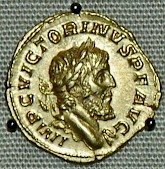
Victorinus needed some time to establish his rule. In Central Gaul, the city of Autun did not immediately support him, and the winter of 269-279 witnessed a protracted siege. In the end, however, Victorinus overcame all problems.
It is interesting that the Germanic tribes remained quiet during the crisis of 269: Postumus had really improved the defenses of the Rhine frontier. The author of the Historia Augusta, which contains so many errors, is for once correct when he writes that the emperors of the Gallic Empire were...
...defenders of the renown of Rome. All of these, I believe, were given by gift of the gods, in order that [...] no opportunity might be afforded the Germans for seizing Roman soil. For if they had broken forth then in the same manner as did the Visigoths and the Persians, these foreign nations, acting together in Roman territory, would have put an end to this venerable empire of the Roman nation.
Decline
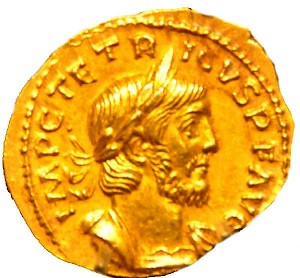
In the spring of 271, Victorinus died. There is no reliable report about the circumstances, but it seems that the empress-mother Victoria was able to choose a new ruler, a man named Tetricus, who may or may not have been a relative of Victorinus. It was only now that the Franks and Alamans tried to invade the empire again, but they were easily defeated. The empire's system of defense was perfect.
The end came in the summer of 274. Aurelian, who had in 270 been recognized by the Roman Senate, crossed the Alps and defeated the army of Tetricus near Châlons-sur-Marne in one of the most bloody battles that was ever fought in a Roman civil war. The victor proudly called himself restitutor orbis, "rebuilder of the world", and from an Italian point of view, he was right. However, his successes were the greatest catastrophe in the history of Gaul and the Rhineland.
Disaster
Many soldiers were dead, and the Frankish and Alamannic warlords easily overran all country north of the Alps, where they were supported by those Franks who had been settled inside the empire by Postumus. They had been living as peasants for fourteen years, which was not enough to fully romanize them.
The Rhine forts were sacked (e.g. Remagen), and manpower shortage caused the fall of the remaining military settlements. Cologne and Trier were captured and looted, Neuss was destroyed, Maastricht depopulated, Voorburg abandoned, and Bavay razed to the ground. Many people in Tongeren never received a proper burial Saxonian pirates also intervened and may have been responsible for large-scale destruction in Flanders. The Roman fort at Aardenburg was never occupied again. In several towns in northern France, hastily constructed walls were destroyed by the invaders: Metz and Reims were sacked and Paris was burning. Extensive areas in Germania Inferior were now depopulated, like the hinterland of Cologne.
Those parts of Gaul that were left in peace, fell victim to another plague: the inhabitants were forced to pay high taxes, which were used to maintain the armies of the Danube and Euphrates. The Rhine frontier was left unguarded, and countless Alamans and Franks settled in the Roman empire.
And yet, this was not the end of Roman culture north of the Alps. Later emperors like Probus and Maximianus recovered Gaul, and Constantius I Chlorus reconquered the Lower Rhine area. In the fourth century, the great Roman empire was divided into four prefectures, which were more or less autonomous units, each responsible for the defense of one part of the frontier. The western praefecture was, essentially, a rebirth of the Gallic Empire.